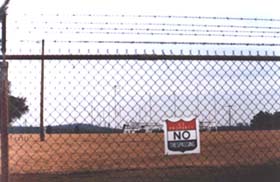View the Weblinks and
Credits affiliated with this feature.

Training Center, National Communication System,
Remington, Virginia. Photo credit: Chris Smolinski |
For much of the last century, shortwave radio was the only way to hear broadcasts from far away. Like many other listeners, producer David Goren fell in love with the sound of the shortwave bands. Slices of uncut indigenous culture collide with wild eyed political propaganda. The hokey chitchat of amateur radio operators contrasts with clipped and cryptic military communications.
Eventually, if listeners dig around long enough, they'll tune across voices reciting endless strings of numbers. These broadcasts have been heard for at least 40 years. The signals are powerful, but they contain no information about location of the transmitter or the intended audience. Most listeners linger for a short time, then tune away, utterly baffled.
Starting in the mid-70's the "Numbers Stations" began to pique the curiosity of a small group of listeners. Numbers enthusiasts began using new receivers with digital readouts to better track these stations. Some, like Simon Mason and Hugh Stegman, spent hours hunting for and recording these stations. They compiled schedules through reverse engineering. Others, like Havana Moon and John Fulford, relied on hints from contacts at intelligence agencies and the Federal Communications Commission. They took to the road with radio direction finding equipment. The shortwave hobby press started to carry reports of stations nicknamed Cynthia, The Babbler, The Sexy Lady, and Bulgarian Betty. Out of this research has come a body of recordings that span the era of the cold war, and a strong feeling that the stations are run by intelligence agencies sending encrypted messages to agents in the field.
Here are some links affilated with this feature
Spy Centre: Spy Numbers Stations
www.spynumbers.com
Chris Smolinski's site features station profiles, audio samples and links to other numbers station sites. The highlight is a database with over 20,000 loggings of numbers stations. Accessing the database is the easiest way to figure what station might currently be on the air. Also available is information on how to join the "Spooks" listserv which tracks the numbers and related stations.
Shortwave Espionage
www.btinternet.com/~simon.mason/page30.html
Simon Mason's site contains his out of print book, Secret Signals, The Euro Numbers Mystery, and a wealth of other written materials. There are also several audio files and photographs of transmitter sites.
The Conet Project
www.ibmpcug.co.uk/~irdial/conet.htm
The Conet Project is a four CD set of numbers station recordings from the past 30 years released in 1997 by Irdial Discs.
Credits for this feature
The Numbers Stations recordings featured are from the collections of:
Simon Mason
Don Mussell
Tom Sevart
Chris Smolinski (from his cd-rom The Numbers Racket.)
The Conet Project
(a four CD set of Numbers Stations, produced by Akin Fernandez and Irdial Discs.)
The Havana Moon interview originally aired in 1992 on Radio Netherland's Media Network program, hosted by Jonathan Marks. Simon Mason provided the recording of the interview.
You need the free RealAudio player to listen to audio files.
Copyright © 2000 The Kitchen Sisters

